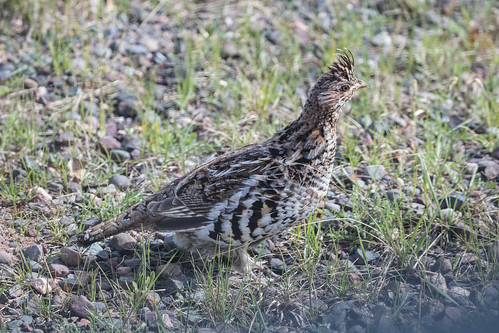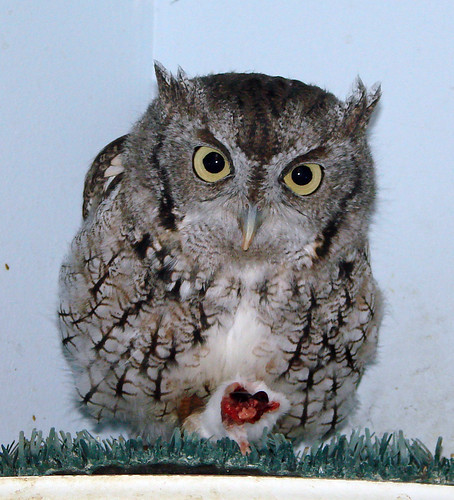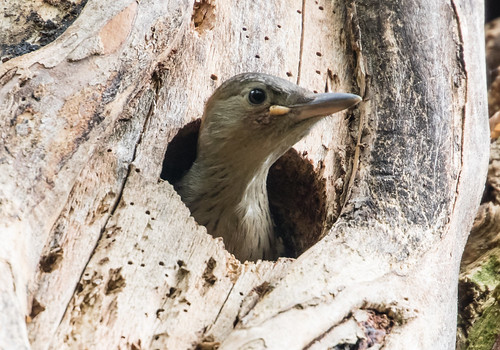 |
| Evening Grosbeaks, the very first species on my yard list, were very common when we first moved here in 1981. |
Russ and I moved into our house on Peabody Street in July 1981. Even as we were carrying the first boxes into the house, I was starting my yard list, with Evening Grosbeaks calling and a Bald Eagle flying overhead. To count a bird on my yard list, either I or the bird must be touching my property. If I’m home, I can count a hawk flying overhead or a bird perched in a neighbor’s yard or anything I hear. If I’m at a neighbor’s, I can count a bird sitting in my tree, but not a bird flying over and nothing calling unless I can see it in my yard. My first autumn here, I was up at Hawk Ridge when a Golden Eagle flew over. I was thrilled, but suddenly realized I wanted it for my yard list. It was moseying, so I jumped in my car, drove home, jumped out of my car, looked up, and barely caught it while it was still identifiable. That afternoon, when I was planting tulips, I looked up and saw another.
My yard list grew by leaps and bounds our first few years here. I’ve never ever had a lifer in my own backyard, but I have had three close calls. A month after we moved here, Russ and I went a bit north of Two Harbors where Kim Eckert said I’d have my best chance of a Boreal Chickadee. Sure enough, I got it, but had I only waited, I’d have gotten my lifer in my backyard that November.
 |
| I've seen these beautiful guys in my yard, but only photographed them in the Bog. |
I got word of Bohemian Waxwings a few blocks north of me our first winter here, and just a few days later, a big flock was in my own yard.
 |
| Bohemian Waxwings used to be very common every year. |
And that first autumn, Kim Eckert called me about a couple of Harris’s Sparrows on Park Point. I drove out, added the lifer, came home, looked out the window, and guess what was right there at my feeder?
I live in a regular neighborhood in Duluth a mile from the lake. I’ve had flyover loons, some waterfowl, American White Pelicans, and a Pied-billed Grebe, but my yard list is missing a lot of very common Minnesota birds. In the four decades we’ve been here, I brought my yard list up to about 170, including 27 species of warblers and my best claim to fame, 7 species of owls. I don’t know that I’ll ever see a Snowy, Northern Hawk Owl, or Short-eared from my yard, though I’ve seen them all in Duluth. The rarest owl on my yard list is the Eastern Screech-Owl—we’re just north of their range. One fall night, my education owl Archimedes started calling and acting weird, so I went outside and heard the wild screech owl and got a few glimpses.
The hardest bird to add to my list was the Barred Owl who was perched on a roof two doors down, with trees and a house blocking the view from almost everywhere in my yard. To add it by my list rules, I had to stand on our cyclone fence leaning over at a jaunty angle, hanging on to an old apple tree for dear life. But I saw it!!
Besides the screech-owl, I’ve had other genuine rarities, too, including a Rufous Hummingbird, Varied Thrush, and Townsend’s Solitaire. The most disappointing rarity I added, a few years ago, was a Blue-winged Warbler. This is such a gorgeous species, and I love them, but they’re expanding their range northward and genetically swamping out my beloved Golden-winged Warbler. I was sad that they’ve reached Duluth now.
I never saw a cardinal in my yard until they were becoming fairly common throughout Duluth. I saw my first Red-bellied Woodpecker in December 1981, when they were still extremely rare up here. It was several years before I saw another, and years more before they were starting to be regular up here. In 2016, a pair nested in my very own box elder tree. That was the first nest ever reported in St. Louis County, but my two birds weren’t the first to breed here—Mike Hendrickson and others, including me, had seen fledglings with their parents years before that.
The longest awaited fairly common bird for me to add to my list was the Golden-winged Warbler. My very first fall here, a group of birders came over for dinner during Hawk Ridge Weekend, and one of them saw a Golden-wing in my yard, but I missed it and year after year after year, I never saw one. For a few years, I tried luring them in during spring migration by playing recordings, but year after year after year, I never saw nor heard a single one. Finally I saw one in 2015, after living here for 34 years, and Ive seen them a couple of times since, all after I'd given up on the recordings. I still don't have a photo of one here.
The bird that took the most technological assistance to add to my yard list was the American Woodcock. A few of them used to display down by the train tracks on Superior Street, 6 blocks from my house. One night I sat up on our roof with my parabolic microphone and listened hard in every direction until I could finally hear them. If we can use binoculars and spotting scope to bring distant birds closer visually, why not a parabola to bring them closer aurally?
Anyway, new yard birds are very difficult for me to come by nowadays. But on Friday morning, September 11, 2020, the very day that I’d done my podcast and blog post about Ruffed Grouse, my neighbor Jeanne called—a Ruffed Grouse was strolling through her front yard that very moment.
 |
| A pre-enactment. This photo was taken at Crex Meadows. I didn't get a photo of my yard Ruffed Grouse. |
I was holding my baby grandson Walter at the time. I ran to the window, and lo and behold! There it was! So at four weeks of age, Walter has a bird on my yard list that took me 39 years to see. And that makes me very happy.







